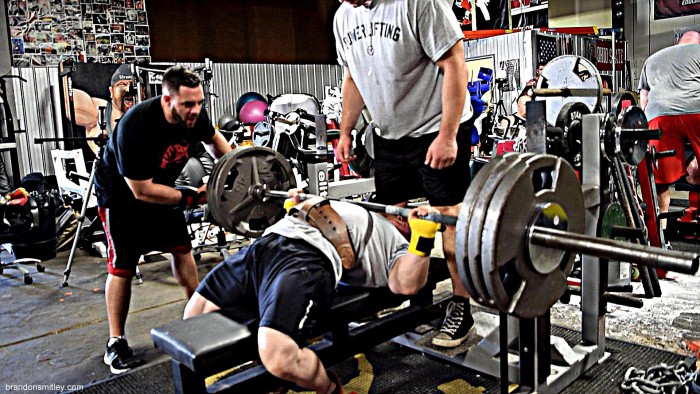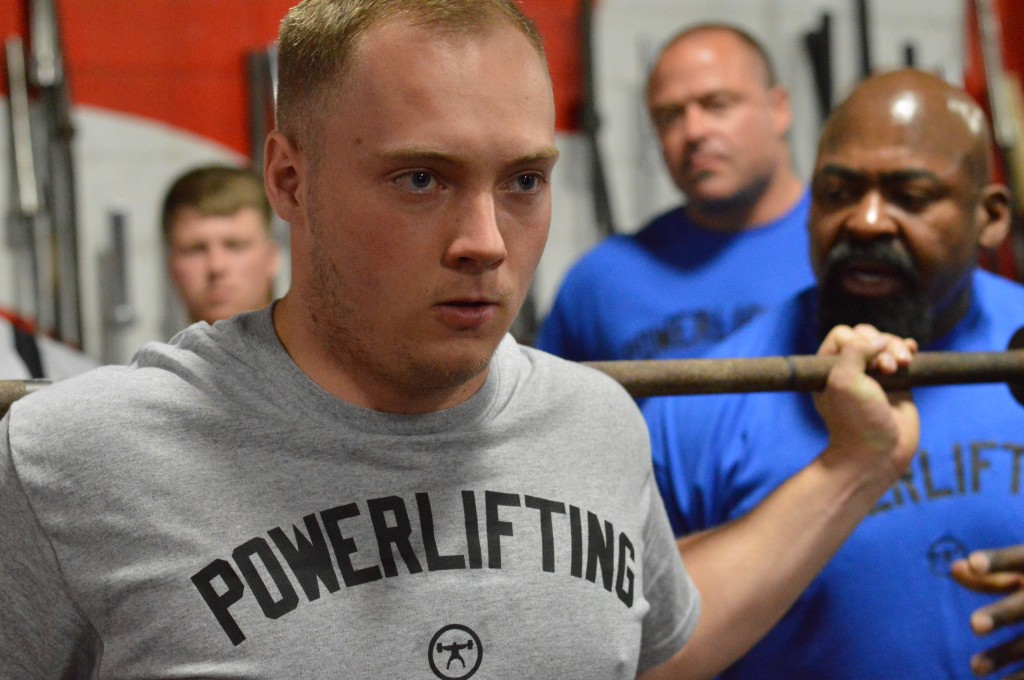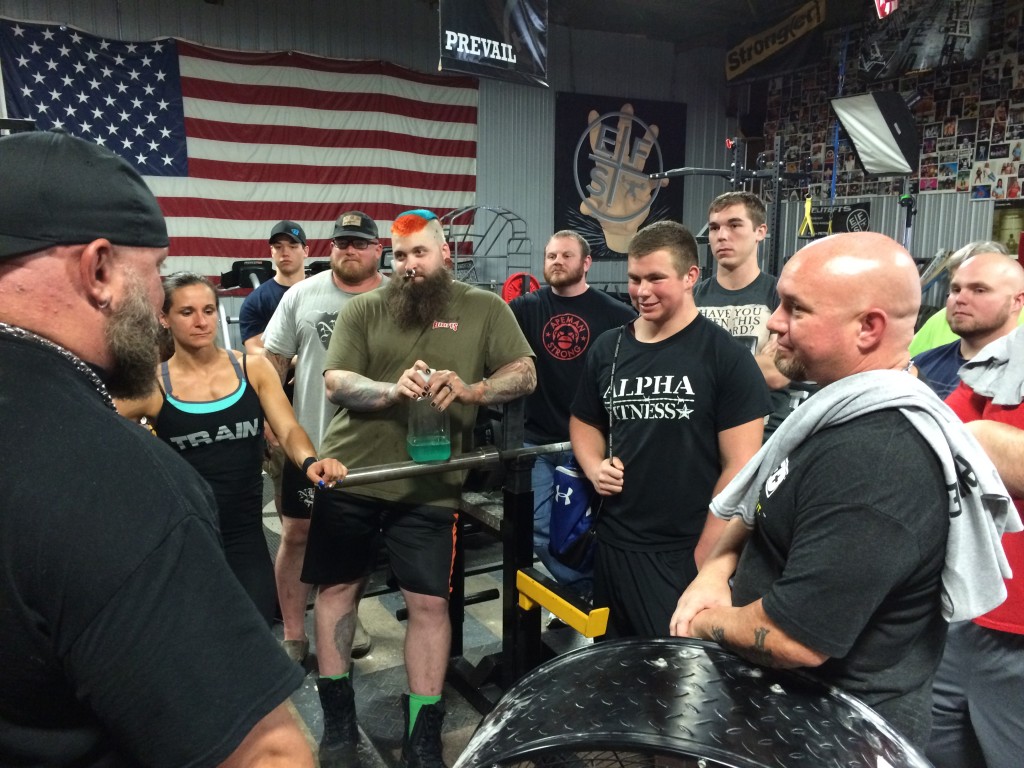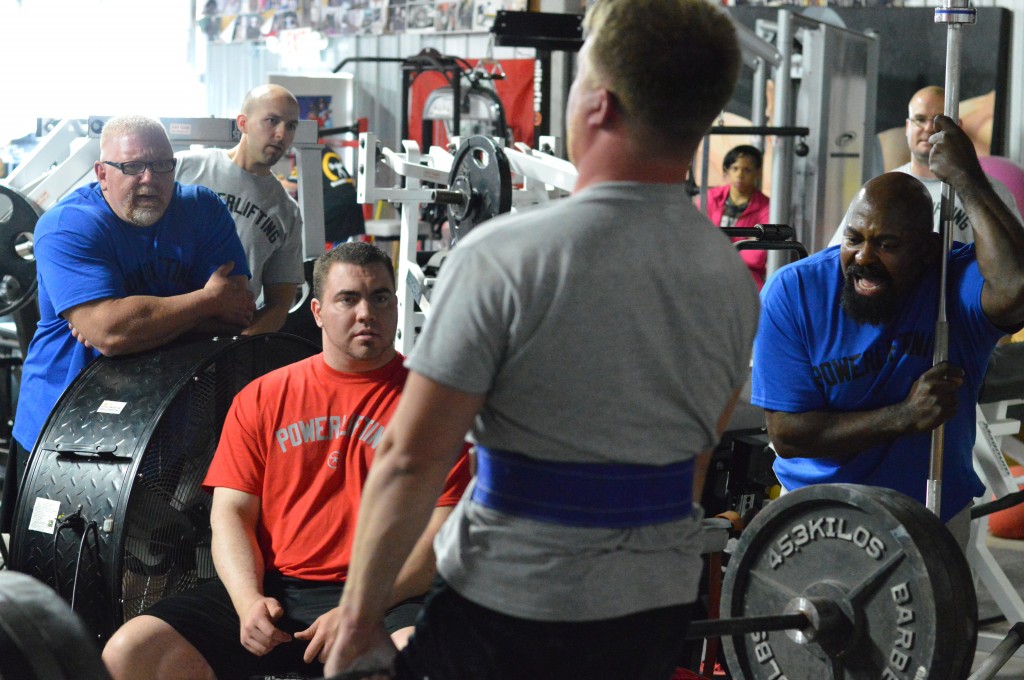
I'm currently in a off season style of training, trying to bring up weak points and improve body composition for the duration of the summer. At the end of summer I will reevaluate where I stand, and decide whether I would like to compete in the late fall, or wait until the XPC Finals in March of 2016.
For programming and coaching inquires, please email SmitleyPerformanceSystems@gmail.com
I would first like to provide an apology of my brief lapse of training log updates. I have had some personal issues for a minor leave of updates, and felt that it was best that I take some personal time away from much internet work. I have still been training, but personally, I just needed the space. Thank you.
Sunday
After a crazy night on Saturday, Sunday morning I woke up and got some fuel in me to head off to bench. Based upon how the night went (WILD!), I had no idea going in how things were going to go. I opted to bench considering I rarely get to be with so many of my awesome teammates. Crazy enough, I felt rather good and managed to hit some nice PR's. I really cranked the volume on my accessory work as I missed out on some stuff on Friday. It was also probably a nice way to work off a bit of all the garbage I ate all weekend. At the end of the day, it was a good training day, and I'm glad I listened to my body rather than just calling it quits early.
I want to give a huge thank you to Dave and Traci, and all the elitefts staff for all their hard work to make this seminar literally the best that has probably been done. I took away so much, even as a coach, with things that I need to work on and use to help my own clients and training partners. Not to mention we raised $1,000 for the Make-A-Wish Foundation. I also can't thank the attendees enough either. While I would have loved to meet each and every one of you, there was a lot going on. I personally want to thank you for taking the time out of your work, school, family, and other obligations to come share the weekend with the team. Without you, Elitefts would not be possible, and we can't tell you how happy we are to see your PR's and emotion all day long. You were all very coachable and very understanding with the things we were telling you. You coming to this seminar not only made you a better lifter, but a better person. I would also like to thank my coaching group for teaching me some new things. Being around such great minds is always so rewarding, and I'm thankful to have a team and support group like Elitefts.
In addition to this log, I've also added three of the biggest things from each lift that I noticed from my coaching group. So for those of you that could not attend, hopefully there is some gold and information you can take away from this...
Three Coaching Cues for the Squat
- Bar Position - This was probably the biggest thing I saw all day. For almost every lifter we had then adjust their bar position on their back. Many people were trying to carry a low bar position (which is great!), but they typically had it too low on their back. This was causing their elbows to pop up (chicken wings), and chest pitching forward out of the hole. By moving the bar position up just a hair, the upper back and chest stayed in the correct position, and the lats were able to stay engaged much easier.
- Hip External Rotation - The next biggest issue was the lack of external rotation at the hips. This is where all the "tightness" starts at, by "screwing" your feet into the ground. When weights got heavier, this tended to be the first link that broke. When this happens, the knees begin to cave in and glutes can't perform optimally when trying to get you out of the hole. This issue also causes many people to miss depth and actually pitch forward to give them the sensation that they are hitting depth (when they aren't). When this was adjusted, many people were making weights that had look slow move much faster, and the rest of the links up the chain basically fixed themselves.
- The Unrack/Set Up - The final main issue I found myself coaching was a good unrack position. Many lifters were unracking the bar with their hips not under the bar. I like to coach lifters to "pick" the bar out of the rack, with their glutes/hips right under the bar. If you are in a monolift, you will let the bar settle, then squat. If you are walking it out, after the bar briefly settles, begin your walk out with a 2-3 step max walkout. Anything more is just a waste of energy (especially under maximal loads). This initial set up many times will decide whether you get or miss the lift. Everything else needs to be locked into place, but if you unrack slightly forward or good morning the weight out, chances are you're going to miss the lift. Coaching a good unrack set many people up to handle loads they've never had on their backs, with incredible confidence and control.
Three Coaching Cues for the Bench Press
- Hand Position - For majority of the lifters we were coaching, I noticed that most of them could use some adjusting to their hand position to maximize their press. Some were too close, others too wide. Ideally, you hand should be right underneath your elbow. Some lifters may deviate a bit from this, but this is a good starting point. When the wrist is inside the elbow, this can cause undue stress to the joints, make the press longer than it needs to be, and have the lifter stalling about 3-4 inches off the chest (making you think you always need to bring up the triceps). But moving that hand position out about an inch or so can let the lats and shoulders do their role much better. As for going too wide, this seems like a great idea as it shortens the press, but the lack of power and getting the triceps involved (to a higher degree, rather than the pecs and shoulders) can be leaving weight off the bar you could be handling. Many reported feeling more powerful as a whole once these adjustments were made.
- Using the Lats - After looking at hand position, many lifters were not using their lats the way they needed to. Trying to break the bar, and keeping the humerus in the proper position not only keeps the shoulder healthier, but can help with staying tight and allowing a good press when given the command. Really squeezing the bar, and thinking about "breaking" it, can cue to depress the scapula and give you a more solid foundation to press from.
- Foot Position - The final major thing I noticed was adjusting foot position. Now for some, we needed to figure out which federation they competed in (as rules may vary, determining what the lifter can/can't do). Once that was established, we could decide whether tucking or having the feet out would be the best route. Many lifters that tucked were trying to tuck too much, and didn't have a solid footing to press the balls of their feet down to generate force. Once that was done, we could focus on squeezing the bench with the adductors and pressing the heels to the floor for maximum leg drive. For those that had flat feet, understanding that their legs need to be out in front, and really pushing the heels down (similar to a box squat) and driving the traps down into the bench and the force coming up into the bar. These lifters tend to not have problems with their butts coming up, but the concept of continually pressing into the floor from the lift off had to be drilled constantly.
Three Coaching Cues for the Deadlift
- Hip Position - For about every lifter that we worked with, finding the correct hip position was key. Some were too low, while others were too high. When the hips are too low, the lifter is leaving out a good amount of hamstring recruitment and utilization. This can be noted that when the lifter pulls the weight, their hips rise, THEN the bar breaks the floor. Starting with the hips a bit higher results in less energy being expended and prevents the chest and shoulders from rounding forward. When the hips are too high, the lifter is again leaving out some hamstring usage, but also putting their lower back in a much more riskier position for injury. This can be seen when the lifter pulls the weight, their hips go nowhere, but their lower back and upper back round hard, and you end up with a "scared cat" like deadlift. When we got the lifters to drop their hips a little bit, they had more leg drive and better body positioning, especially at lockout. With a bit more roundback style of deadlifting, it makes it hard to get the glutes through for the lockout.
- Pulling the Slack out of the Bar - For some lifters it was their first time using a deadlift bar. Many people when they use this bar for the first time have a hard time grabbing the concept of pulling the slack out. Whether you compete with a deadlift bar or not, this really doesn't matter (just the amount of slack you can pull out is going to change). Pulling the slack out prevents you from not only rounding and your hip position from being changed, but helps you set the lats and generate tension from the beginning of the lift by loading the hamstrings. This should lead to a more powerful position from the floor and getting the bar to break the ground. How you opt to pull the slack out (via your style) is going to be personal preference, but it should be noted that is an important factor as many times this can decided whether the bar breaks and you get the lift, or it leaves you stapled.
- Distance from the Bar - The final thing I found myself coaching was where the feet were placed in relation to the bar. This is going to depend upon stance and build of the lifter, but having the bar set up in the correct spot may determine whether the bar breaks the floor or not. If you pull conventional and are shorter with stockier legs (bigger quads), you will not want your shins against the bar in most cases. Having the bar about an inch away, or over the midfoot will make it easier once you pass the knee due to the enlarged quads or stockier build. As for longer lifters, you may find that your shins are almost touching the bar, and your knees may even be over the bar a bit. This is okay, as once the bar breaks and is almost to the knee, the longer limbs will have you in a leverage point that your knees are almost locked out at this point. When it comes to sumo, regardless of build, your shins are probably going to be against the bar or very close to it. However, it should be a goal to get your hips as close to the bar as possible. A cue I used for this is if we tie a string to your belt, the string should be touching the bar. This will get you the best leverages to get the bar to break the floor, typically the hardest part for most sumo deadlifters.
Hopefully you can take something away from each lift and apply them to your training to help you break a new PR if you were unable to attend the Powerlifting Experience 2!
[youtube=https://www.youtube.com/watch?v=jQWsZYcccvc]
Items Used in this Training Session
Chains
EZ Loaders
Swiss Grip Lat Pulldown Bar
Long Ab Strap
Warm Up
DB Bench Press - 50's x4x12
Mini Band Face Pull - 4x25
A1) Bench Press
50x10
100x5
140x5
190x3
230x3
260x3
280x3
300x3 - PR
330x1 - PR
330x4 - 2 board
320x1 - 2 board + 2 chains per side
B1) Close Grip 2 Board vs Chains
190x2x10 - drop set of chains on last set
C1) Decline Chain Skull Crushers
3x20
D1) Swiss Bar Lat Pulldowns
10x10
E1) Spring Bar Push Ups
3 sets of failure
F1) Reverse Pec Deck
5x20
G1) Standing Cable Crunches
4x12
H1) Roman Chair Leg Raises
2 sets of failure











